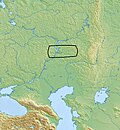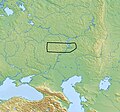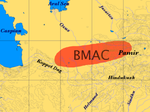 | The Abashevo culture (Russian: Абашевская культура, romanized: Abashevskaya kul'tura) is a late Middle Bronze Age archaeological culture, ca. 2200–1850... 25 KB (2,936 words) - 17:15, 15 April 2024 |
 | as a result of interaction between the Abashevo culture, the Catacomb culture and the early Andronovo culture. Evidence of Catacomb influence has been... 28 KB (3,366 words) - 05:13, 19 April 2024 |
 | findings that the Sintashta culture originated from the interaction of the two precursors Poltavka culture and Abashevo culture. Allentoft et al. (2015)... 46 KB (4,898 words) - 01:19, 21 April 2024 |
 | Kurgan hypothesis (redirect from Kurgan culture) prehistoric cultures, including the Yamnaya (or Pit Grave) culture and its predecessors. In the 2000s, David Anthony instead used the core Yamnaya culture and... 34 KB (3,825 words) - 17:47, 22 April 2024 |
Longshan Qijia Xichengyi Linya Zhukaigou Shimao Baodun Shijiahe Abashevo Culture Catacomb Culture ◁ ▷ Shimao (Chinese: 石峁; pinyin: Shímǎo) is a Neolithic site... 7 KB (636 words) - 12:01, 18 January 2024 |
 | Maykop culture (Russian: майкоп, [mɐjˈkop], scientific transliteration: Majkop,), c. 3700 BC–3000 BC, is a major Bronze Age archaeological culture in the... 22 KB (2,637 words) - 10:03, 11 April 2024 |
 | Commons has media related to Middle Dnieper culture. Sredny Stog culture Milograd culture Abashevo culture Nordqvist and Heyd, The Forgotten Child of the... 4 KB (474 words) - 08:40, 25 November 2023 |
 | Cycladic culture (also known as Cycladic civilisation or, chronologically, as Cycladic chronology) was a Bronze Age culture (c. 3100–c. 1000 BC) found... 14 KB (1,530 words) - 01:19, 10 April 2024 |
The Glazkov culture, Glazkovo culture, or Glazkovskaya culture (2200-1200 BCE), was an archaeological culture in the Lake Baikal area during the Early... 13 KB (1,283 words) - 23:22, 4 April 2024 |
 | Sintashta (category Sintashta culture) unprecedented intensity of metallurgical production for the steppe. Early Abashevo culture ceramic styles strongly influenced Sintashta ceramics. Due to the assimilation... 7 KB (762 words) - 21:45, 6 March 2024 |
 | The Hallstatt culture was the predominant Western and Central European archaeological culture of the Late Bronze Age (Hallstatt A, Hallstatt B) from the... 76 KB (8,519 words) - 22:53, 23 April 2024 |
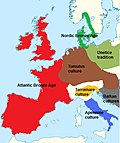 | The Tumulus culture (German: Hügelgräberkultur) was the dominant material culture in Central Europe during the Middle Bronze Age (c. 1600 to 1300 BC)... 24 KB (2,074 words) - 10:23, 25 April 2024 |
The Tagar culture was a Bronze Age Saka archeological culture which flourished between the 8th and 1st centuries BC in South Siberia (Republic of Khakassia... 20 KB (1,924 words) - 01:17, 21 April 2024 |
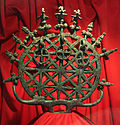 | the Abashevo culture. The Sintashta culture expanded further eastwards into central Asia becoming the Andronovo culture, whilst the Srubnaya culture (c... 110 KB (12,453 words) - 08:08, 22 April 2024 |
 | Sarmatians (redirect from Sarmatian culture) of the Eurasian Steppe, the Sarmatians were part of the wider Scythian cultures. They started migrating westward around the fourth and third centuries... 80 KB (8,681 words) - 19:12, 19 April 2024 |



